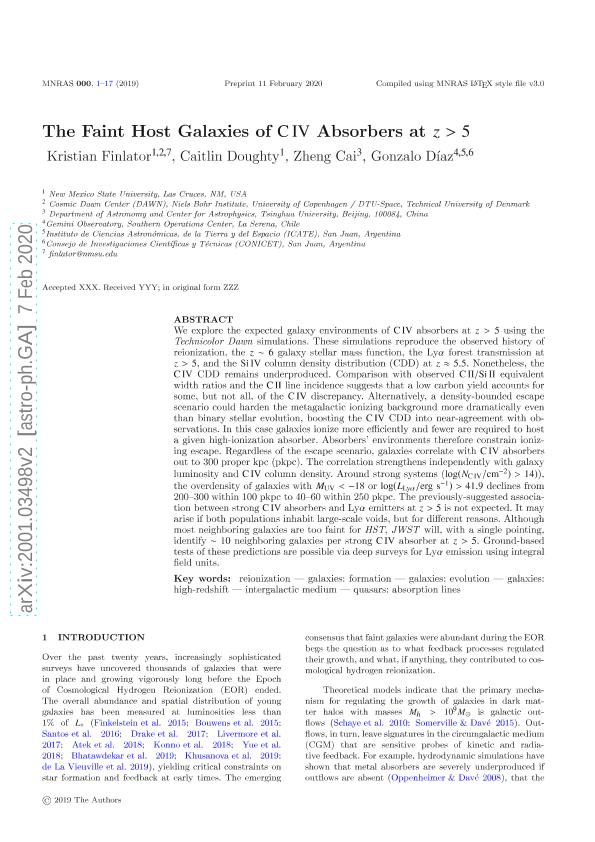Mostrar el registro sencillo del ítem
dc.contributor.author
Finlator, Kristian
dc.contributor.author
Doughty, Caitlin
dc.contributor.author
Cai, Zheng
dc.contributor.author
Diaz, Carlos Gonzalo

dc.date.available
2021-10-06T15:58:12Z
dc.date.issued
2020-02-18
dc.identifier.citation
Finlator, Kristian; Doughty, Caitlin; Cai, Zheng; Diaz, Carlos Gonzalo; The faint host galaxies of CIV absorbers at z > 5; Wiley Blackwell Publishing, Inc; Monthly Notices of the Royal Astronomical Society; 493; 3; 18-2-2020; 3223-3237
dc.identifier.issn
0035-8711
dc.identifier.uri
http://hdl.handle.net/11336/142883
dc.description.abstract
We explore the expected galaxy environments of CIV absorbers at z > 5 using the Technicolor Dawn simulations. These simulations reproduce the observed history of reionization, the z ~ 6 galaxy stellar mass function, the Ly a forest transmission at z > 5, and the Si IV column density distribution (CDD) at z ~ 5.5. None the less, the CIV CDD remains underproduced. Comparison with observed CII/Si II equivalent width ratios and the CII line incidence suggests that a low carbon yield accounts for some, but not all, of the CIV discrepancy. Alternatively, a density-bounded escape scenario could harden the metagalactic ionizing background more dramatically even than binary stellar evolution, boosting the CIV CDD into near agreement with observations. In this case, galaxies ionize more efficiently and fewer are required to host a given high-ionization absorber. Absorbers´ environments therefore constrain ionizing escape. Regardless of the escape scenario, galaxies correlate with CIV absorbers out to 300 proper kpc (pkpc). The correlation strengthens independently with galaxy luminosity and CIV column density. Around strong systems (log(NCIV/cm-2) > 14)), the overdensity of galaxies with MUV < -18 or log (LLy a/erg s-1) > 41.9 declines from 200-300 within 100 pkpc to 40-60 within 250 pkpc. The previously suggested association between strong CIV absorbers and Ly a emitters at z > 5 is not expected. It may arise if both populations inhabit large-scale voids, but for different reasons. Although most neighbouring galaxies are too faint for HST, JWST will, with a single pointing, identify ~10 neighbouring galaxies per strong CIV absorber at z > 5. Ground-based tests of these predictions are possible via deep surveys for Ly a emission using integral field units.
dc.format
application/pdf
dc.language.iso
eng
dc.publisher
Wiley Blackwell Publishing, Inc

dc.rights
info:eu-repo/semantics/openAccess
dc.rights.uri
https://creativecommons.org/licenses/by-nc-sa/2.5/ar/
dc.subject
GALAXIES: EVOLUTION
dc.subject
GALAXIES: FORMATION
dc.subject
GALAXIES: HIGH-REDSHIFT
dc.subject
INTERGALACTIC MEDIUM
dc.subject
QUASARS: ABSORPTION LINES
dc.subject.classification
Astronomía

dc.subject.classification
Ciencias Físicas

dc.subject.classification
CIENCIAS NATURALES Y EXACTAS

dc.title
The faint host galaxies of CIV absorbers at z > 5
dc.type
info:eu-repo/semantics/article
dc.type
info:ar-repo/semantics/artículo
dc.type
info:eu-repo/semantics/publishedVersion
dc.date.updated
2021-08-19T20:33:03Z
dc.journal.volume
493
dc.journal.number
3
dc.journal.pagination
3223-3237
dc.journal.pais
Reino Unido

dc.description.fil
Fil: Finlator, Kristian. Technical University of Denmark; Dinamarca
dc.description.fil
Fil: Doughty, Caitlin. New Mexico State University; Estados Unidos
dc.description.fil
Fil: Cai, Zheng. Tsinghua University; China
dc.description.fil
Fil: Diaz, Carlos Gonzalo. Gemini Observatorysouthern Operations Center; Chile. Consejo Nacional de Investigaciones Científicas y Técnicas. Centro Científico Tecnológico Conicet - San Juan. Instituto de Ciencias Astronómicas, de la Tierra y del Espacio. Universidad Nacional de San Juan. Instituto de Ciencias Astronómicas, de la Tierra y del Espacio; Argentina
dc.journal.title
Monthly Notices of the Royal Astronomical Society

dc.relation.alternativeid
info:eu-repo/semantics/altIdentifier/doi/http://dx.doi.org/10.1093/mnras/staa377
dc.relation.alternativeid
info:eu-repo/semantics/altIdentifier/url/https://academic.oup.com/mnras/article/493/3/3223/5739927
Archivos asociados
